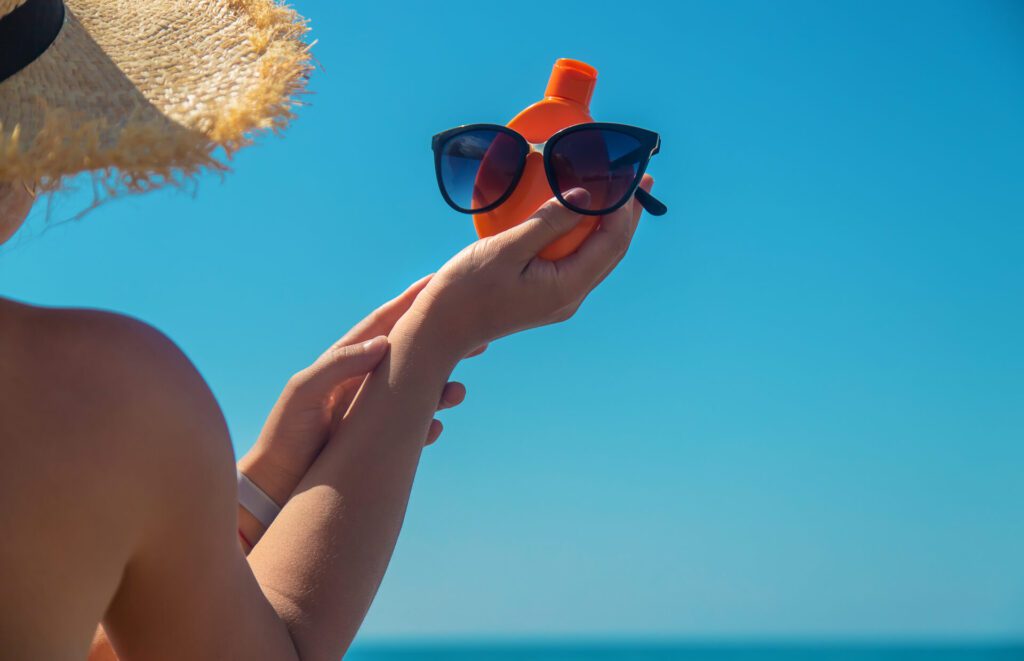The drastic climatic changes are making us more cautious and protective of our skin to protect it from the sun’s harmful rays. It’s quite important for maintaining healthy, youthful skin and preventing long-term damage.
But these days, with so many sun protection products and types available on the market, it can be confusing which one you should choose. In the skin care market , sunscreen and sunblock are two common but confusing options. Each comprises a different ingredient , offering different benefits and protection levels.
In this guide, London Aesthetic UK have got you covered. We’ll share all you need to know, so keep reading! As in this, we’ll break down the difference between sunscreen and sunblock and, in a simpler way, remove the SPF confusion, and share expert tips on how to select and apply the best sun protection for your skin. No matter the season, from a quick walk outside to a full day in the sun , the right sun protection is essential for your everyday skincare.

Sunblock Vs Sunscreen
When it comes to optimal protection from the harmful effects of the sun , the terms “sunscreen” and “sunblock” come to mind and are often used interchangeably. However, they are not the same; next time when you go to a scour for the best shield against the sun, keep your eyes open and mind running.
But what is the key difference between sunscreen and sunblock?
What is sunscreen?
Sunscreen is a chemical product that acts as a chemical filter by absorbing some UV radiation, converting it into heat , and preventing it from penetrating the skin.
Ingredients:
Understanding the key ingredients in sun protection products helps in making an informed choice. Sunscreen for sun protection, particularly include oxybenzone, avobenzone, octinoxate, octisalate, homosalate, and octocrylene.
In addition to that, the sunscreen is typically thinner and more easily absorbed in the skin.Sunscreen is usually lightweight, easy to apply, and blends well with the skin, making it a popular choice for daily use.
What is Sunblock?
Meanwhile, Sunblock is a physical product—sun protection—that reflects UV rays away from the skin. It actually , in simpler terms, forms a physical barrier on the skin’s surface, deflecting UV rays away.
Ingredients:
Sunblock typically contains mineral ingredients like zinc oxide and titanium dioxide, which physically reflect the sun’s rays.
Sunblock is often thicker and may leave a white residue on the skin, but it provides immediate protection upon application.
“Up to 80% of UV rays penetrate clouds, meaning sunscreen is essential even on cloudy days.”
Why should sunscreen or sunblock be used ?
Whether you have to work outside where the sun has to kiss you.Or in the summer, a poolside day with family is great for family bonding , boosting moods, and to enjoy.
But unfortunately, such an outing doesn’t come without its risks. Right. Here , where Suncreen and Sunblock came in as your savior. Next time you are about to buy sunscreen or sunblock, always try to see these key entitlements on that particular product: UV rays, SPF , and ingredients.
THE SCIENCE BEHIND IT ?
-
UV Rays
The sun exposes us to ultraviolet radiation, or UV rays. Such UV radiations are not detectable to the human eye and classified by wavelength. The main segregations of UV rays are UVA, UVB (mainly concerned), and UVC.
Actually, the shorter UV rays are absorbed by the atmosphere’s ozone layer, so by the time UV radiation contacts our body, most of it is in the form of UVA and some in UVB.
The UVB rays only penetrate the top layers of your skin, while UVA rays penetrate much deeper due to their longer wavelength. While UVB rays only cause superficial injury and inflammation (like sunburn) and play a significant role in producing skin cancers , UVA rays possibly cause deeper damage, adding to your risk of getting cellular changes leading to premature aging and skin cancer.
How do you ensure that you are protected?
For that, check this out.
The Ingredients of Sunblock and Sunscreen
- The Ingredients of Sunscreens
Compounds such as the following are typically found in a sunscreen’s formulation of mixed chemical filters:
- Oxybenzone:
A compound that absorbs UVB rays and short UVA rays.
- Avobenzone:
Provides broad-spectrum protection against radiation rays.
- Octinoxate:
Absorbs mainly UVB rays.
- Octocrylene:
Absorbs UVB rays and some UVA rays and stabilizes the other materials.
- The Ingredients of Sunblock
Sunblocks usually consist of mineral-based ingredients such as:
- Zinc Oxide:
Zinc oxide offers broad-spectrum protection against both UVA and UVB rays.
- Titanium Dioxide:
Offers protection largely against UVB and short UVA rays.
The mineral components make sunblock less likely to cause skin irritation, thus a better option for sensitive skin.
SPF: Rating And What They Mean
What is SPF?
SPF, or Sun Protection Factor, measures how well a sunscreen or sunblock can protect the skin from UVB rays, which are responsible for sunburn. The SPF rating indicates the amount of time you can stay in the sun without getting burned compared to unprotected skin.
SPF Ratings Explained
- SPF 15: blocks about 93% of UVB rays.
- SPF 30: blocks about 97% of UVB rays.
- SPF 50: blocks about 98% of UVB rays.
While higher SPF offers more protection, no sunscreen or sunblock can provide 100% protection. It’s essential to reapply every two hours, especially after swimming or sweating. But use it as it is important for better skincare.
Broad-Spectrum Protection
You may have seen the word Broad-Spectrum Protection on sun protection products. The broad-spectrum sunscreen protects against both UVA and UVB rays.So , always opt for broad-spectrum sunscreen.

How To Choose The Best Sun Protection
- Skin Type
Oily Skin: Opt for oil-free, non-comedogenic sunscreens that won’t clog pores.
Dry Skin: Choose sunscreens with added moisturizers or hydrating ingredients.
Sensitive Skin: Mineral-based sunblocks with zinc oxide or titanium dioxide are less likely to cause irritation.
- Activity Level
Daily Use: Lightweight, broad-spectrum sunscreens with SPF 30 are ideal for everyday wear.
Outdoor Activities: Water-resistant sunscreens or sunblocks with higher SPF are better for prolonged sun exposure.
Broad-Spectrum Protection
Always choose a product that offers broad-spectrum protection, meaning it protects against both UVA and UVB rays. UVA rays penetrate deeper into the skin and are responsible for premature aging, while UVB rays cause sunburn.
Is Sunscreen better than Sunblock?
The London Aesthetic UK, as experts in the aesthetic industry, say the answer depends on your skin type, lifestyle, and personal preference. Sunscreen is generally more cosmetically elegant, making it easier to incorporate into your daily skincare routine. However, sunblock is often recommended for sensitive skin or for those who need immediate protection without waiting for the product to absorb.
Role Of Sun Protection In Skin Care
- Preventing Premature Aging
UV rays are a leading cause of premature aging, including wrinkles, fine lines, and age spots. Regular use of sunscreen or sunblock can help maintain youthful skin by protecting it from UV damage.
- Reducing Skin Cancer Risk
Prolonged exposure to UV rays increases the risk of skin cancer. Using sun protection daily can significantly reduce this risk by shielding the skin from harmful radiation.
- Maintaining Even Skin Tone
Sun protection helps prevent hyperpigmentation and dark spots, ensuring an even skin tone. This is especially important for those with melasma or other pigmentation issues.
Best Sun Protection Practices For Skin
- Daily Application
Make sun protection a part of your daily skincare routine. Apply sunscreen or sunblock every morning, even on cloudy days, as UV rays can penetrate through clouds.
Daily sunscreen use can reduce skin aging by 24%. (According to a study published in Annals of Internal Medicine.)
- Reapplication
Reapply sunscreen or sunblock every two hours, especially if you’re outdoors, swimming, or sweating. No product can provide all-day protection, so reapplication is key.
- Layering Products
Apply sunscreen or sunblock as the last step in your skincare routine, but before makeup. This ensures that the product forms an effective barrier on the skin.
Best Practices For Applying Sunscreen And Sunblock
- Amount to Use
Use about a teaspoon of sunscreen or sunblock for your face and a shot glass amount for your body. Most people underapply, which reduces the effectiveness of the product.
- Application Technique
Sunscreen: Apply evenly and allow it to absorb into the skin for about 15-20 minutes before sun exposure.
Sunblock: Apply generously and evenly, ensuring full coverage. It provides immediate protection, so no need to wait.
- Don’t Forget These Areas
Often missed areas include the ears, back of the neck, hands, and feet. Make sure to cover these areas to ensure complete protection.
“The FDA recommends using at least one ounce of sunscreen (a shot glass full) for full-body coverage.”
What Should You Consider Before Buying Sunscreen?

- SPF Level
Choose an SPF that suits your skin type and the level of sun exposure you expect. For daily use, SPF 30 is usually sufficient, but for prolonged outdoor activities, consider SPF 50.
- Broad-Spectrum Protection
Because for better skin care,ensure the product offers broad-spectrum protection to guard against both UVA and UVB rays.
- Water Resistance
If you’re swimming or sweating, opt for a water-resistant formula that will stay effective for longer.
- Skin Sensitivity
If you have sensitive skin, look for fragrance-free and hypoallergenic formulas. Mineral-based sunblocks are often better for sensitive skin.
- Expiry Date
Check the expiration date before purchasing. Expired sunscreen or sunblock may not provide adequate protection.
Also, try to consult with professional doctors if you have any specific disease or skin care issue. We, London Aesthetic UK, are always open to help you.Just contact us!
FAQs
- Can I use sunscreen and sunblock together?
Yes, you can layer sunscreen and sunblock for added protection. However, it’s usually unnecessary as long as you’re using a broad-spectrum product with adequate SPF.
- Can I use sunscreen on my baby?
For babies under six months, it’s best to avoid direct sun exposure and use protective clothing. For older babies, use a mineral-based sunblock with zinc oxide or titanium dioxide.
- Is higher SPF always better?
While higher SPF offers more protection, the difference becomes minimal after SPF 30. SPF 30 blocks 97% of UVB rays, while SPF 50 blocks 98%. The key is regular reapplication.
- Can I use sunscreen indoors?
Yes, UVA rays can penetrate windows, so it’s a good idea to wear sunscreen indoors, especially if you’re near windows or using electronic devices that emit blue light.
- How long does sunscreen last?
Most sunscreens are effective for about two hours. After that, you should reapply, especially if you’re swimming or sweating.
Bibliography
- American Academy of Dermatology. (2021). “Sunscreen FAQs.” https://www.aad.org
- Skin Cancer Foundation. (2020). “All About Sunscreen.” https://www.skincancer.org
- FDA. (2019). “Sunscreen: How to Help Protect Your Skin from the Sun.” https://www.fda.gov
- Mayo Clinic. (2021). “Sunscreen: One simple step to protect your skin.” https://www.mayoclinic.org
- WebMD. (2020). “Sunscreen vs. Sunblock: What’s the Difference?” https://www.webmd.com






